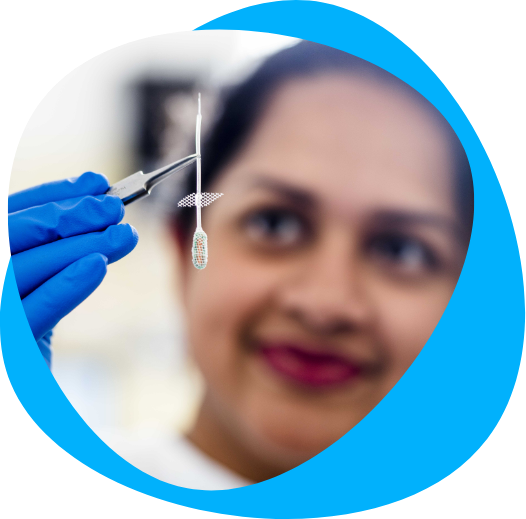Rheumatoid
Arthritis
RA usually starts in the person’s 30s or 40s [3], developing over weeks to months [4]. It attacks symmetrical joints in the hands, wrists and feet, with:
- Stiffness
- Pain
- Swelling
Other joints can be affected, but not usually the back [4].
As well as joint problems, people with RA can experience fatigue, fevers, and problems with their skin, nerves, heart and blood vessels, spleen, lungs, eyes and kidneys.
Research suggests RA is caused by multiple factors, for example:
- A gene has been identified which makes people prone to developing RA [5]
- First-degree relatives of someone with RA are more likely than second-degree relatives to develop RA [6]
- A person related to someone with young onset RA (aged 17-65) is more likely to develop RA than if their relative developed RA after the age of 65 [6]
- Cigarette smoking is the strongest known risk factor for RA [7].
RA is diagnosed mainly by symptoms and physical examination [8]. It is usual for people diagnosed with RA to be referred to a rheumatologist as it can be complex to manage.
Diagnostic tests ordered are listed in Table 1; other tests may be required to exclude other diagnoses and complications of RA. Most people with RA have anti-CCP and/or RhF antibodies, called seropositive RA. Seropositive RA is associated with more severe disease [9].
TABLE 1
Tests used to diagnose rheumatoid arthritis
| Blood tests [10] |
|
|---|---|
| X-Rays or other imaging [8] |
|
*CRP = C-reactive protein, ESR = Erythrocyte sedimentation rate
**Anti-CCP = Anti-cyclic citrullinated peptide; RhF = Rheumatoid factor
Treatment should begin within 12 weeks of diagnosis. This is “the window of opportunity” where intensive treatment can increase likelihood of earlier remission, better physical functioning and quality of life [11].
Your doctor will usually start you on a steroid called prednisolone to help with joint symptoms.
At this time or soon after, a conventional disease-modifying antirheumatic drug (DMARD) is usually started by your rheumatologist, typically methotrexate. DMARDs are the mainstay of treatment as they slow or even halt disease progression.
However, sometimes more than one drug is required due to adverse effects or poor response.
All DMARDs require regular monitoring. Depending on the drug, adverse effects include abdominal pain, nausea, mouth ulcers, anaemia, kidney or liver toxicity, increased risk of infection or cancer.
Table 2 summarises common medications which your doctor may prescribe for you.
TABLE 2
Tests used to diagnose rheumatoid arthritis
| Medication type | Examples | How they work |
|---|---|---|
| Pain relief [10] |
Ibuprofen, diclofenac, meloxicam, celecoxib, steroid injection into joint |
Reduces pain and joint inflammation No evidence that they stop joint damage |
| Oral corticosteroid [12,13] |
Prednisolone |
Reduces inflammation and dampens immune reaction Typically used as “bridging therapy” for up to three months when changes made in DMARD* therapy |
| Conventional DMARDs* |
Methotrexate, leflunomide, sulfasalazine, hydroxychloroquine, prednisolone |
Relieves symptoms Slows disease progression |
| Biologic DMARDs* |
This group is split into several classes depending on their modes of action: drugs include abatacept, adalimumab, anakinra, tocilizumab, rituximab |
Relieves symptoms Slows disease progression |
*DMARD = Disease-modifying anti-rheumatic drug
Currently, there is no cure, and no strong evidence for any particular diet [14] or supplements [15–17] although supervised exercise may help [18,19]
New treatment under development at the Bionics Institute
Bionics Institute researchers are developing an electrical medical device for people with rheumatoid arthritis that aims to:
• Provide a drug-free treatment for rheumatoid arthritis using vagus nerve stimulation
• Trigger the body’s natural anti-inflammatory response to reduce inflammation caused by rheumatoid arthritis
• Give long-term relief from pain and disability without the side effects of drug treatment.
How does it work?
• A tiny electrode array is attached to the vagus nerve just under the diaphragm
• The vagus nerve connects the brain to the gut and controls natural anti-inflammatory processes in the body
• The vagus nerve is stimulated by the electrode array in response to inflammation caused by rheumatoid arthritis
• The vagus nerve initiates a natural anti-inflammatory response and reduces the pain and symptoms of rheumatoid arthritis
• The electrode array is powered by a small battery implanted at hip level.
• The battery only needs to be replaced every 10 years ensuring the device provides a set-and-forget treatment
• The treatment causes fewer side effects than medications
Want to support the future of research like this?
Early-stage research for life-changing devices like this is made possible by donations from our supporters.
Your support today could turn the seed of an idea into a new treatment in the future.
Medical disclaimer
This article contains general information relating to a medical condition. Such information is provided for informational purposes only and does not replace medical advice given by your healthcare professional.
References
1. Australian Institute of Health and Welfare. Rheumatoid arthritis. CC-BY 4.0 [Internet]. 2022 [cited 2022 Apr 30]. Available from: https://www.aihw.gov.au/getmedia/e9824572-0078-42d5-9669-be2f6efd74cf/Rheumatoid-arthritis.pdf.aspx?inline=true
2. Australian Institute of Health and Welfare. Arthritis. CC-BY 4.0 [Internet]. 2020 [cited 2022 Apr 30]. Available from: https://www.aihw.gov.au/reports/chronic-musculoskeletal-conditions/arthritis/contents/arthritis
3. Rheumatoid Arthritis [Internet]. American College of Rheumatology. 2021 [cited 2022 Apr 30]. Available from: https://www.rheumatology.org/I-Am-A/Patient-Caregiver/Diseases-Conditions/Rheumatoid-Arthritis
4. Ruffing V, Bingham III C. Rheumatoid Arthritis Symptoms : [Internet]. Johns Hopkins Arthritis Center. 2022 [cited 2022 Apr 30]. Available from: https://www.hopkinsarthritis.org/arthritis-info/rheumatoid-arthritis/ra-symptoms/
5. Firestein GS. Pathogenesis Of Rheumatoid Arthritis: The Intersection Of Genetics And Epigenetics. Trans Am Clin Climatol Assoc [Internet]. 2018 [cited 2022 Apr 30];129:171. Available from: /pmc/articles/PMC6116585/
6. Frisell T, Holmqvist M, Källberg H, Klareskog L, Alfredsson L, Askling J. Familial risks and heritability of rheumatoid arthritis: role of rheumatoid factor/anti-citrullinated protein antibody status, number and type of affected relatives, sex, and age. Arthritis Rheum [Internet]. 2013 Nov [cited 2022 Apr 30];65(11):2773–82. Available from: https://pubmed.ncbi.nlm.nih.gov/23897126/
7. Klareskog L, Stolt P, Lundberg K, Källberg H, Bengtsson C, Grunewald J, et al. A new model for an etiology of rheumatoid arthritis: Smoking may trigger HLA-DR (shared epitope)-restricted immune reactions to autoantigens modified by citrullination. Arthritis Rheum. 2006 Jan;54(1):38–46.
8. Combe B, Landewe R, Daien CI, Hua C, Aletaha D, Álvaro-Gracia JM, et al. 2016 update of the EULAR recommendations for the management of early arthritis. Ann Rheum Dis [Internet]. 2017 Jun 1 [cited 2021 Oct 6];76(6):948–59. Available from: https://ard.bmj.com/content/76/6/948
9. Malmström V, Catrina AI, Klareskog L. The immunopathogenesis of seropositive rheumatoid arthritis: from triggering to targeting. Nat Rev Immunol 2016 171 [Internet]. 2016 Dec 5 [cited 2022 May 1];17:60–75. Available from: https://www.nature.com/articles/nri.2016.124
10. Royal Australian College of General Practitioners. Clinical guideline for the diagnosis and management of early rheumatoid arthritis [Internet]. 2009 [cited 2022 Apr 30]. p. 1–46. Available from: www.racgp.org.au
11. Monti S, Montecucco C, Bugatti S, Caporali R. Rheumatoid arthritis treatment: the earlier the better to prevent joint damage. RMD Open [Internet]. 2015 Aug 1 [cited 2021 Oct 9];1(Suppl 1):e000057. Available from: https://rmdopen.bmj.com/content/1/Suppl_1/e000057
12. Buttgereit F, Da Silva JPA, Boers M, Burmester GR, Cutolo M, Jacobs J, et al. Standardised nomenclature for glucocorticoid dosages and glucocorticoid treatment regimens: current questions and tentative answers in rheumatology. Ann Rheum Dis [Internet]. 2002 Aug 1 [cited 2022 Apr 30];61(8):718–22. Available from: https://ard.bmj.com/content/61/8/718
13. Smolen JS, Landewé RBM, Bijlsma JWJ, Burmester GR, Dougados M, Kerschbaumer A, et al. EULAR recommendations for the management of rheumatoid arthritis with synthetic and biological disease-modifying antirheumatic drugs: 2019 update. Ann Rheum Dis [Internet]. 2020 [cited 2021 Oct 10];0:1–15. Available from: https://ard.bmj.com/content/annrheumdis/early/2020/01/22/annrheumdis-2019-216655.full.pdf
14. Hagen KB, Byfuglien MG, Falzon L, Olsen SU, Smedslund G. Dietary interventions for rheumatoid arthritis. Cochrane Database Syst Rev. 2009;(1).
15. Proudman SM, James MJ, Spargo LD, Metcalf RG, Sullivan TR, Rischmueller M, et al. Fish oil in recent onset rheumatoid arthritis: a randomised, double-blind controlled trial within algorithm-based drug use. Ann Rheum Dis [Internet]. 2015 Jan 1 [cited 2022 Apr 30];74(1):89–95. Available from: https://pubmed.ncbi.nlm.nih.gov/24081439/
16. Cameron M, Gagnier JJ, Chrubasik S. Herbal therapy for treating rheumatoid arthritis. Cochrane Database Syst Rev. 2011 Feb 16;
17. National Center for Complementary and Integrative Health. Rheumatoid Arthritis: In Depth [Internet]. 2019 [cited 2022 Apr 30]. Available from: https://www.nccih.nih.gov/health/rheumatoid-arthritis-in-depth
18. Cramp F, Hewlett S, Almeida C, Kirwan JR, Choy EHS, Chalder T, et al. Non-pharmacological interventions for fatigue in rheumatoid arthritis. Cochrane Database Syst Rev [Internet]. 2013 Aug 23 [cited 2022 Apr 30];(8). Available from: https://www.cochranelibrary.com/cdsr/doi/10.1002/14651858.CD008322.pub2/full
19. Stenström CH, Minor MA. Evidence for the benefit of aerobic and strengthening exercise in rheumatoid arthritis. Arthritis Care Res. 2003 Jun 15;49(3):428–34.
20. Nikiphorou E, Carpenter L, Morris S, MacGregor AJ, Dixey J, Kiely P, et al. Hand and Foot Surgery Rates in Rheumatoid Arthritis Have Declined From 1986 to 2011, but Large-Joint Replacement Rates Remain Unchanged: Results From Two UK Inception Cohorts. Arthritis Rheumatol [Internet]. 2014 May 1 [cited 2022 May 1];66(5):1081–9. Available from: https://onlinelibrary.wiley.com/doi/full/10.1002/art.38344



